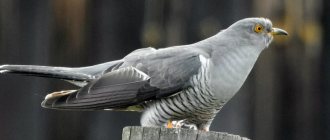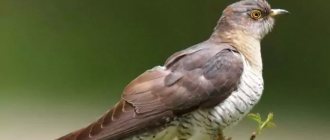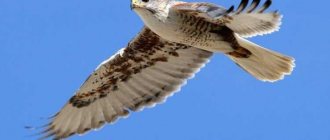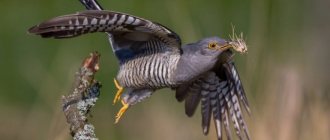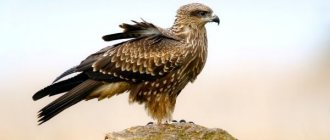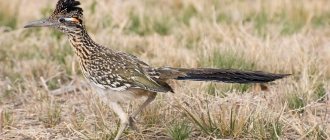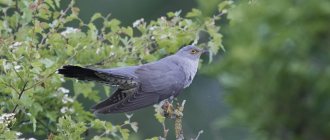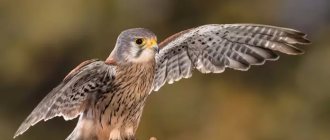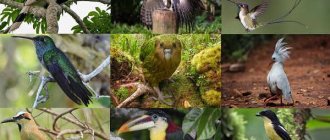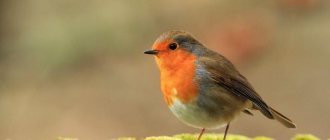This article will talk about one very strange bird, which differs from other birds with its surprisingly unusual behavior. This is a cuckoo, known for laying its eggs or throwing them into the nests of other bird species.
It turns out that her chicks are being fed by completely alien, “foster” parents. This behavior is called nest parasitism. Moreover, each of these birds throws its eggs precisely into the nests of those species of birds that once fed it.
You can learn about their characteristics, in which nests the cuckoo lays eggs and what its chicks are, what they eat, by reading this article. But first we will give general information about them.
Many people know that female cuckoos shift all the worries about their offspring onto other people’s shoulders, so to speak, limiting themselves to searching for ready-made other people’s nests and throwing their eggs into them.
What is the name of the cuckoo chick? Little cuckoo. This is what will be discussed in this article.
What does the forest bird cuckoo look like: description, its size, close-up photo
forest bird cuckoo
Read an article about the Peregrine Falcon bird on our website . It contains information about the appearance, behavior of this predator, nutrition and various interesting facts.
The cuckoo is a member of a large and diverse family of cuckoos, numbering about 140 species . These birds live in all parts of the world, except Antarctica . What does the bird look like? Description, its dimensions:
- Cuckoos that live on different continents vary in size and color.
- The smallest species have a body length of 15 cm , and the largest reach more than 60 cm .
- The color ranges from monochromatic gray to motley-spotted with brown, orange, and even green splashes.
Here's a close-up photo:
forest bird cuckoo
The most famous and widespread species in our forests is the common cuckoo (lat. Cuculus canorus ). It is thanks to the mating song “Ku-ku, ku-ku” , the male of this species, that the family owes its name.
Continuation:
- The common cuckoo is a small, well-proportioned bird, with an average weight of 140 g (100-180 g) , a total length of 32-34 cm , and a wingspan of 55 to 65 cm .
- Males are slightly larger in size and weight than females.
- The color of female and male individuals is different. The male is dark gray in color, the lower chest is white with dark stripes, and the throat area is ash-gray. The tail feathers are whitish-gray with a distinct white tip.
- Females of the species have two colors. Some are very similar to males, but have brownish feathers on the back and throat.
- The second ones are very different in color: a dark orange back and a white chest with dark transverse stripes. The tail is wedge-shaped, measuring 11-15 cm.
- The wings are long ( up to 20 cm ), pointed at the end, gray with a brown tint.
- The cuckoo's legs are small, yellow in color, and have long, hard feathers ending at the very toes with sharp claws.
- The arrangement of the toes on the paws: two look forward, and two look back - helps the bird to sit steadily on the tree, tenaciously grasping the branch.
- But with such legs it is difficult for the cuckoo to move on the ground.
- The small dark beak has the shape of a hook, curved down.
- The eyes are yellow or gray, surrounded by a leathery orange ring.
- Despite the fact that it is rare that no one has heard the cooing, the bird is mostly silent.
- The cuckoo's song can be heard during the mating season from May to July .
In nature, the cuckoo lives for about 10 years .
General information about the cuckoo
Different types of cuckoos differ in size. Most birds belonging to the cuckoo family weigh barely 100 grams and have a body length of no more than forty centimeters.
But all representatives of this family are characterized by the presence of a rather long tail, strong paws and a thin body. And the plumage, as a rule, is not particularly brightly colored. And sexual dimorphism in color is either poorly developed or absent altogether.
There are no cuckoos only in the Arctic and Antarctic. But in general, their distribution area is wide throughout the globe, and they are especially fond of warm countries. Some species living in temperate latitudes are mostly migratory, while the rest are sedentary.
In the nests of which birds does the cuckoo lay eggs?
The cuckoo lays eggs in the nests of various birds.
Cuckoos do not nest or build their own nests, being nest parasites. This is due to the physiological characteristics of the bird. The cuckoo does not lay eggs simultaneously, like many birds, but with an interval of 3-5 days . Over the summer, the female is capable of laying 10-15 eggs , and to hatch the chicks she would need to remain in the nest for 2 months In addition, the bird simply could not feed such a number of cuckoo chicks. Therefore, to raise its children, the cuckoo selects adoptive parents for them:
- The cuckoo does not lay its egg in the first nest it comes across, but carefully selects future educators for its offspring.
- Moreover, the search for a suitable pair begins at the stage of nest construction.
- More often she tries to leave her egg to the species of birds that she herself was fed.
- When laying an egg, the male helps the female.
- He flies around someone else's nest, pretending to be a predator and driving away the owners.
- As soon as they fly away, the female cuckoo lays her egg in the nest, it only takes her 15 seconds .
- Simultaneously with laying its own, the cuckoo destroys the host egg.
- The bird throws only one egg into each nest. Therefore, future parents, returning to the nest, do not notice the substitution and continue to hatch the chicks.
- The emerging cuckoo gets rid of both the eggs and the already hatched chicks, remaining the only subject of care for the adoptive parents.
In the nests of which birds does the cuckoo lay eggs? The adoptive parents of cuckoos are a large number of different birds that feed the chicks by placing food in their beaks. More often the parents of cuckoos are:
- Wagtails
- Kamyshovki
- Robins
- Flycatchers
- Warblers
- Finches
- Swifts
- Sparrows
- Finches
- Mints
- Redstart
- Other birds of the passerine family
Evolutionary development has endowed the cuckoo with the amazing ability to lay eggs that repeat the size or color of those in which they are laid. Therefore, the eggs of the common cuckoo differ significantly in size, from 15 to 23 mm , and color - 1117 species (from white to deep blue, large and small spotted).
Nest parasitism
The main and interesting feature of the cuckoo is the laying of eggs in the nests of birds of other species. At the same time, all concerns regarding incubation and subsequent feeding of the offspring are transferred to the “adoptive parents”. How does this happen? More on this later.
Cuckoos lay their eggs in other people's nests. And for this, the female occupies a certain area of the territory, where she looks out for suitable bird houses. There are cuckoos that mainly use the nests of white wagtails, some - the nests of warblers, others - pipits, etc. According to scientists, cuckoos are divided into unique “biological tribes” that have adapted to parasitize certain species of small birds.
Almost all such representatives of the family live in the eastern hemisphere, and monogamous people live in the western hemisphere. The first, as you remember, do not form pairs: in one area there are only one female and several males, less often their ratio is the opposite.
In parasitic species, the eggs are very small, they are slightly larger than the eggs of many small birds, to which the mother throws them into the nests. And in shape and color, they are also very similar to the eggs of their host birds, or very slightly different.
How does a cuckoo chick grow?
When the cuckoo chick grows, it pushes all the other eggs out of the nest.
In total, 11-12 days , so its chick hatches earlier, beginning its struggle for survival. How does a cuckoo chick grow?
- The cuckoo chick is born completely blind and naked, there is no embryonic down, the weight is 2.5 -3.5 g .
- For the first 4-5 days, foster parents not only feed, but also warm the baby.
- As soon as it is born, the cuckoo chick tries to get rid of eggs or already hatched chicks.
- He pushes the eggs of his adoptive parents over the edge of the nest.
- In a similar way, he positions himself under the chick, pushing it towards the edge, and throws it out.
- He performs all his actions involuntarily; this instinct manifests itself in the cuckoo for the first 4 days , disappearing subsequently.
- The chick is unusually gluttonous. Moreover, in order to stimulate its adoptive parents to intensive feeding, the cub emits special loud cries that imitate the voices of the host chicks.
These loud calls often attract predators, who destroy birds' nests and kill their chicks. Although the chicks begin to fly at the age of three weeks, they continue to feed at the expense of their caregivers. Only six weeks after birth, cuckoo chicks leave the nest of the parents who fed them.
What kind of birds does the cuckoo belong to: genus, species
Cuckoo
More detailed information about the species of these birds. Common cuckoo:
- Genus - cuckoos
- Subfamily - true cuckoos
- Family - cuckoo
- Order – cuckoo-shaped
- Class – birds
The cuckoo family includes 6 subfamilies, 28 genera and more than 140 species . Cuckoos are the most numerous genus, with 15 species , including the common cuckoo.
Is the cuckoo a migratory bird or a resident one?
Cuckoo is a migratory bird.
Cuckoos are migratory birds. They are not sedentary. more than 3-4 months in their breeding areas . 6 thousand kilometers to their wintering grounds about 80 kilometers per day . Thus, they spend 2-2.5 months .
The common cuckoo chooses wintering sites:
- African countries
- India
- Southern territories of China
- Ceylon
When choosing a wintering place, cuckoos try to find settlements similar to their native ones, so they never winter in the desert. Interestingly, adult birds fly away for the winter immediately after laying eggs. That is, a month earlier than young cuckoos, which leave for migration at the end of August - beginning of September, and independently find their way to wintering places.
Where do they live?
Koel - lat. Eudynamys scolopaceus
The habitat of cuckoos includes all continents with the exception of Antarctica, as well as islands located in the Atlantic and Pacific Oceans. The largest number of varieties is found in Europe, Asia and North America.
Where live
Gigantic cuckoo - lat. Scythrops novaehollandiae
The natural habitat of cuckoos is very diverse. They can be found in the taiga, in coniferous and deciduous forests, in the forest-steppe, in ribbon forests, and thickets of bushes growing near water bodies. Birds often settle in gardens and parks located within populated areas. Some species inhabit semi-deserts poor in vegetation and are found in the foothills at altitudes of up to 3000 m above sea level.
Where do they spend the winter?
Four-winged cuckoo - lat. Tapera naevia
Since the range of cuckoos is very extensive, birds living in temperate latitudes are migratory. Before the onset of cold weather, they migrate to southern Africa, the Arabian Peninsula, south and southeast Asia. Birds living in subtropical or tropical climates do not leave their habitat throughout the year or make periodic short flights.
Cuckoos begin to leave their wintering grounds earlier than many other birds. At first, they gather in flocks and slowly move north, covering no more than 70-80 km per day. Subsequently, the flocks are divided into small groups, and the birds reach the nesting site one by one. The migration, which begins in early March, usually ends in early or mid-May.
Is the cuckoo bird harmful?
Cuckoo
There are no useless animals or plants in nature. Although seemingly harmful at first glance, they turn out to be an important part of the ecosystem.
So it is with the cuckoo - this not very large bird destroys a large number of forest pests. She has an excellent appetite: she can eat up to 100 caterpillars 1,500 a day Moreover, its food becomes harmful and poisonous insects that other birds do not eat:
- Ticks
- Pine silkworms
- Furry caterpillars
The cuckoo is considered the orderly of the forest. It almost completely clears its habitat of pests, and, like a wolf among animals, limits the bird population, maintaining its optimal level.
Common cuckoo bird: interesting facts
Common cuckoo bird
The name “cuckoo” comes from the well-known song “cuckoo, cuckoo” , which is not similar to the singing of any other bird. You will find other interesting facts about the common cuckoo bird below.
The bird, known in the world since ancient times in different countries, has a similar name, similar to the sounds it pronounces:
- In Bulgaria it is called “kukovitsa”
- Germany – “kukuch”
- Czech Republic - “kukača”
- Romania – “kukul”
- Italy - "cuculo"
Latin name: Cuculus canorus
, comes from two words:
Cuculus (cuckoo) and canorus (melodic; from canere - to sing).
The most interesting features distinguish the common cuckoo:
- From year to year, the cuckoo returns to its previous place of residence, and precisely to its territorial area.
- The bird is subject to molting twice a year: partial - in summer and full - in winter.
- If it is impossible to lay an egg directly into the nest, the bird can lay it nearby, and then, taking it in its beak, deliver it to the nest of the chosen future parents.
There have been cases of laying eggs in this way even in tree hollows.
Interesting Facts
• The chick is very demanding when it comes to feeding, so it persistently gets its way. It often happens that he is fed not only by “foster” parents, but also by other birds.
• The cuckoo has different similar names in other countries: the Bulgarians call it “kukovitsa”, in Romania the word “cook” is common, the Germans called it “cuckoo”, the Czechs called it “cuckoo”, the French simply called it “cuckoo”, and the Italians called it “cuckoo”. doll."
• The coloring of the cuckoo is basically the same as that of the sparrowhawk. Perhaps this is not accidental, since thanks to this the cuckoo can easily drive away its owners from the nest.
• Redstarts and warblers most often become caregivers of cuckoo cubs.
Habits of an interesting cuckoo bird: description
Habits of an interesting cuckoo bird
The cuckoo leads a diurnal but secretive lifestyle. She is very careful, hides among the branches of tall trees and flies away when people approach. Most of the time the cuckoo is engaged in obtaining food, living in dense thickets, only occasionally descending to the ground for prey. Due to the structural features of its paws, the bird practically does not move on the ground and leaves no traces there. But she feels great in the air, her flight is distinguished by ease and swiftness. Here is another description of the habits of the interesting cuckoo bird:
- She is silent for the vast majority of the year and prefers a lonely, solitary existence.
- This way of life is disrupted only during courtship, from the end of spring until almost the end of summer.
- At this point, the birds begin to show interest in each other, forming seasonal pairs.
- During mating games, fierce fights between males occur. The birds become noisy, spreading their tails like a fan, trying to attract the attention of females.
- The famous “coo-coo, peek-a-boo” is the dominant mating song of the male.
- Females also sing during this period, but their singing is compared to a gurgling trill or a low vibrating whistle.
The birds' songs are loud, audible at a distance of two kilometers, long and sonorous for the male, quieter for the female. The couple’s relationship is characterized by romanticism: in gratitude for the choice, the male gives his chosen one a stem or twig.
Types of cuckoos
In the cuckoo family, the following species are of greatest interest:
Crested cuckoo
lat. Clamator glandarius
It lives in southwestern Europe, Western Asia, and southern Africa. You can distinguish a male from a female by a more luxuriant and longer tuft of feathers on the head. Unlike their relatives, eggs are laid not on passerines, but on raven birds.
Indian hawk-cuckoo
lat. Cuculus (Hierococcyx) varius
It has a very strong external resemblance to a hawk. Often, when it appears, small birds and squirrels emit calls of danger, mistaking the cuckoo for a predator.
Fan-tailed bristly cuckoo
lat. Cacomantis flabelliformis
Found in Australia, Tasmania and some islands of Oceania. He prefers to hunt in open spaces, attacking prey in the air or on the ground. In addition to traditional insects, small reptiles and mammals, and chicks of other bird species often become prey for the bristly cuckoo.
Plantain cuckoo
lat. Geococcyx californianus
Lives in southern North America. They move mostly on land, occasionally making short flights. The only bird that can eat killer wasps and tarantulas.
Guira
lat. Guira Guira
Lives in tropical forests of South America. The bird has a fairly bright color; a crest of long feathers is noticeable on its head. Male and female guira build nests at a height of about 5 m.
Bird of the cuckoo family: what does it eat?
Bird of the cuckoo family
cuckoo family is omnivorous birds. They can eat food of both animal and plant origin. What do they eat? The main part of the animal diet consists of insects:
- Caterpillars
- Beetles
- Mosquitoes
- Grasshoppers
- Slugs
- Ticks
- Spiders
- Ant larvae
- Snails
- Butterflies
- Worms
In addition to insects, certain types of cuckoos prey on young lizards, snakes, frogs, small rodents, and they are not averse to feasting on bird eggs. And, although cuckoos prefer animal food, their diet may include fruits of various shrubs and trees. Worth knowing:
- Cuckoos, unlike other birds, are able to use poisonous insects as food, including hairy caterpillars covered with poisonous chitinous hairs.
- The venom of the caterpillars is destructive to almost all birds; only cuckoos and orioles eat them.
- They have adapted to remove the poisonous gut of an insect before eating it.
- Cuckoos, although small, are very voracious birds.
- They devote all their free time to searching and eating food.
- And if it were not for the cuckoos, which are capable of destroying one and a half thousand caterpillars, beetles and larvae per day, the trees would be left without foliage. Their excessive appetite helps to accumulate subcutaneous fat necessary for flight during migration.
Cuckoos look out for their prey while sitting on a tree. Having good eyesight, they are able to see it at a distance of 45 m . Cuckoos are able to catch and eat an insect both on the fly and by picking it up from a tree or ground.
About varieties
The number of the entire order of cuckoos is approximately 150 species, united in 39 genera. They are divided into 2 suborders: true cuckoos, containing one family of cuckoos, and turacos, containing one family of turacos (or banana-eaters).
Most of the members of the family are shrubby and arboreal. Their life passes in the crown of bushes and trees. Among them there are species leading a terrestrial lifestyle. They build their nests on the ground.
Many cuckoos are monogamous. During the breeding season, they form pairs, build nests themselves, incubate eggs and feed their chicks.
About 50 species are polygamous, in which nest parasitism is clearly expressed.
People often ask the question: “Why does the cuckoo abandon its chicks?” It turns out that this is typical only for polygamous cuckoos.
What bird looks like a cuckoo?
The dove is similar to the cuckoo.
The cuckoo has similar features to many birds. What bird looks like a cuckoo?
- Even in ancient times, its resemblance to a hawk was noted. Indeed, the appearance of the bird: the color of the plumage, the shape of the head and the flight style are reminiscent of a falcon or a hawk. This similarity helps the cuckoo to scare away birds in whose nests it intends to lay its eggs.
- The bird resembles a pigeon in size, but has a more aristocratic build.
The structure of the cuckoo's paws with diametrically opposite toes makes it similar to woodpeckers, owls or parrots.
Description
Before we find out what a cuckoo chick is, we will describe its parents.
The cuckoo is slightly smaller in size than the pigeon. Males and most females have an ash-gray head and upper body. The underside is striated in color (“hawk” type). There are females that have a rusty-red color on the upper side of the body. The tail is quite long - reaches 15-19 centimeters, and the wings grow to 20-30 centimeters. In this regard, the cuckoo appears to be a large bird, especially in flight. In fact, it is small, and its weight is only 120 grams (maximum).
More details about what a cuckoo chick is (see photo below) can be found later in the article.
Cuckoos are considered to be medium-sized birds: the smallest species are only slightly larger than a sparrow, and the largest are like crows. They have rigid plumage that fits well to the body. But the fluff is rather poorly developed.
The elongated shin feathers of these birds form a kind of “pants”. The wings of most members of the family are long and sharp (there are only 10 primary flight wings, the longest of which is the third).
The stepped long tail usually has 10 tail feathers. The four-toed legs of cuckoos are short.
The young cuckoo (chick) differs from its old relatives in the browner coloration of the upper body, as a rule, with rusty-red transverse stripes. The cuckoo's tail has a white tip, while rufous females have a dark stripe along the edge.
The male makes sounds in the form of “cuckoo”, sometimes turning into muffled laughter. Females are characterized by a ringing sound “kli-kli-kli”. Usually the cuckoo crows no more than ten times in a row.
Which trees does the cuckoo like to sing on: birch
The cuckoo loves to sing on the birch tree.
As you know, the cuckoo sings only during courtship, therefore its singing places are limited to the zone of subsequent distribution of laid eggs. In which trees does the cuckoo like to sing?
This cautious bird prefers to settle in mixed forests. Observing silence and caution, the cuckoo can be seen at the forest edge, sitting on a birch tree. The bird is also often spotted on larch, rowan, pine, and willow. If you see a tree with a lot of caterpillars in the forest, know that a cuckoo is nearby and will definitely come to the rescue.
